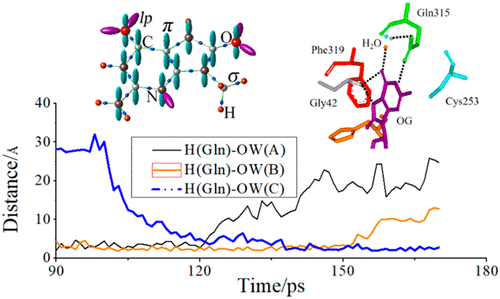当前位置:
X-MOL 学术
›
J. Chem. Theory Comput.
›
论文详情
Our official English website, www.x-mol.net, welcomes your
feedback! (Note: you will need to create a separate account there.)
Water-Mediated Oxidation of Guanine by a Repair Enzyme: Simulation Using the ABEEM Polarizable Force Field
Journal of Chemical Theory and Computation ( IF 5.7 ) Pub Date : 2021-05-21 , DOI: 10.1021/acs.jctc.1c00107 Cui Liu 1 , Change Lv 1 , Yu-Ying Yao 1 , Xue Du 1 , Dong-Xia Zhao 1 , Zhong-Zhi Yang 1
Journal of Chemical Theory and Computation ( IF 5.7 ) Pub Date : 2021-05-21 , DOI: 10.1021/acs.jctc.1c00107 Cui Liu 1 , Change Lv 1 , Yu-Ying Yao 1 , Xue Du 1 , Dong-Xia Zhao 1 , Zhong-Zhi Yang 1
Affiliation

|
The recognition mechanism of oxidative damage in organisms has long been a research hotspot. Water is an important medium in the recognition process, but its specific role remains unknown. There is a need to develop a suitable force field that can adequately describe the electrostatic, hydrogen bond, and other interactions among the molecules in the complex system of the repair enzyme and oxidized base. The developing ABEEM polarizable force field (PFF) has been used to simulate the repaired enzyme hOGG1 and oxidized DNA (PDB ID: 1EBM) in a biological environment, and the corresponding results are better than those of the fixed-charge force fields OPLS/AA and AMBER OL15. 8-Oxo-G is recognized by Gln315 of hOGG1 mainly through hydrogen bonds mediated by continuous exchange of 2 water molecules. Phe319 and Cys253 are stacked on both sides of the π planes of bases to form sandwich structures. The charge polarization effect gives an important signal to drive the exchange of water molecules and maintains the recognition of oxidation bases by enzymes. The mediated main water molecule A and mediated auxiliary water molecule B together pull Gln315 to recognize 8-oxo-G by hydrogen bond interactions. Then, the charge polarization signal of solvent water molecule C with a large absolute charge causes the absolute charge of O atoms in water molecule A or B to increase by approximately 0.2 e, and water molecule A or B leaves Gln315 and 8-oxo-G. The other water molecule and water molecule C synergistically recognize 8-oxo-G with Gln315. Even though the water molecules between Gln315 and 8-oxo-G are removed, the MD simulation results show that water molecules appear between Gln315 and 8-oxo-G in a very short time (<2 ps). The dwell time of each water molecule is approximately 60 ps. The radial distribution function and dwell time support the correctness of the above mechanism. These polarization effects and hydrogen bonding interactions cannot be simulated by a fixed-charge force field.
中文翻译:

修复酶对鸟嘌呤的水介导氧化:使用 ABEEM 极化力场进行模拟
生物体氧化损伤的识别机制长期以来一直是研究热点。水是识别过程中的重要介质,但其具体作用尚不清楚。需要开发一个合适的力场,以充分描述修复酶和氧化碱复杂系统中分子之间的静电、氢键和其他相互作用。开发中的 ABEEM 极化力场 (PFF) 已被用于模拟生物环境中修复的酶 hOGG1 和氧化 DNA (PDB ID: 1EBM),相应的结果优于固定电荷力场 OPLS/AA和琥珀色 OL15。8-Oxo-G 主要通过 2 个水分子的连续交换介导的氢键被 hOGG1 的 Gln315 识别。Phe319和Cys253在碱基的π平面两侧堆叠形成夹层结构。电荷极化效应提供了一个重要的信号来驱动水分子的交换并维持酶对氧化碱基的识别。介导的主要水分子A和介导的辅助水分子B一起通过氢键相互作用拉动 Gln315 识别 8-oxo-G。然后,具有较大绝对电荷的溶剂水分子C的电荷极化信号使水分子A或B中O原子的绝对电荷增加约0.2e,水分子A或B离开Gln315和8-oxo-G . 另一个水分子和水分子C与 Gln315 协同识别 8-oxo-G。即使 Gln315 和 8-oxo-G 之间的水分子被去除,MD 模拟结果表明水分子在很短的时间内(<2 ps)出现在 Gln315 和 8-oxo-G 之间。每个水分子的停留时间约为 60 ps。径向分布函数和停留时间支持上述机制的正确性。这些极化效应和氢键相互作用无法通过固定电荷力场来模拟。
更新日期:2021-06-08
中文翻译:

修复酶对鸟嘌呤的水介导氧化:使用 ABEEM 极化力场进行模拟
生物体氧化损伤的识别机制长期以来一直是研究热点。水是识别过程中的重要介质,但其具体作用尚不清楚。需要开发一个合适的力场,以充分描述修复酶和氧化碱复杂系统中分子之间的静电、氢键和其他相互作用。开发中的 ABEEM 极化力场 (PFF) 已被用于模拟生物环境中修复的酶 hOGG1 和氧化 DNA (PDB ID: 1EBM),相应的结果优于固定电荷力场 OPLS/AA和琥珀色 OL15。8-Oxo-G 主要通过 2 个水分子的连续交换介导的氢键被 hOGG1 的 Gln315 识别。Phe319和Cys253在碱基的π平面两侧堆叠形成夹层结构。电荷极化效应提供了一个重要的信号来驱动水分子的交换并维持酶对氧化碱基的识别。介导的主要水分子A和介导的辅助水分子B一起通过氢键相互作用拉动 Gln315 识别 8-oxo-G。然后,具有较大绝对电荷的溶剂水分子C的电荷极化信号使水分子A或B中O原子的绝对电荷增加约0.2e,水分子A或B离开Gln315和8-oxo-G . 另一个水分子和水分子C与 Gln315 协同识别 8-oxo-G。即使 Gln315 和 8-oxo-G 之间的水分子被去除,MD 模拟结果表明水分子在很短的时间内(<2 ps)出现在 Gln315 和 8-oxo-G 之间。每个水分子的停留时间约为 60 ps。径向分布函数和停留时间支持上述机制的正确性。这些极化效应和氢键相互作用无法通过固定电荷力场来模拟。













































 京公网安备 11010802027423号
京公网安备 11010802027423号